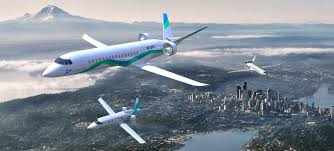One of the more fun things to do is research new trends in aviation. Whether you are interested in the latest avionics advancements or airframe design, there is truly no shortage of new data to crunch.
Technology is continually evolving, and as part of a high-tech industry, aviation fans get to witness some of the most exciting advancements made available to the general public. This is especially true as we see sweeping changes within the industry when it comes to the accessibility of private air travel and the impact of aviation on the environment.
How is private aviation around the world expected to change in the new year?
Keep reading to learn more about the trends private jet manufacturers are expecting to deploy very soon.
1. A Focus on Sustainability
Sustainability is a buzz word in just about every industry this year, and private aviation is no exception. Stakeholders want to see corporate jet manufacturers going green and are rewarding those who are taking a stand for the sake of the environment. Are people publicly shamed for owning a business jet? If you have a story to share, please email it to me. I am emailable at Jason@VREF.com.
As is the case across the board, customers are looking for brands whose values align with their own. Private jet manufacturers are demonstrating their commitment to sustainability by investing in electric research and striving to create planes that are more efficient and produce less noise.
Manufacturers Rolls-Royce, Airbus, and Siemens are investing in hybrid-electric propulsion and changing the future of the industry. Cessna, Bombardier, and Gulfstream are working to improve the efficiency of their aircraft to reduce their carbon footprint as well.
Specifically, these manufacturers are creating flight plans with more efficiency to reduce fuel burn. Keep in mind that sustainability is a broad term, and investing in sustainability isn’t a one size fits all approach.
2. Increased Accessibility
We’ve seen a trend towards increased accessibility for the past decade. Private aviation is reaching new audiences, particularly small and medium-sized companies that can benefit from its services.
Private aviation is becoming more flexible and efficient and opening the door to new customers. Smaller companies that wouldn’t have traditionally chartered private jets are recognizing the benefits and the value doing so can bring to their business.
Traditionally, most business travelers had to fly commercial. Commercial flights, especially to smaller airports, required making at least one, sometimes more, connections to get to their destination. With a change in the landscape of private aviation, it’s becoming more affordable to fly privately.
It’s becoming more cost-efficient to take a private flight and have the freedom to land wherever you want. We see marketing approaches demonstrating the value of using private aviation to benefit companies’ bottom lines. This really should be no surprise; after all, NBAA has been using the “No Plane, No Gain” mantra for over a decade. Still, many businesses felt there was a negative stigma associated with owning and operating their aircraft. Today, with more options for alternatives to ownership and several aircraft that we consider “flying under the radar” or at least don’t garner the attention as some of their bigger brothers, there are several new people from an emerging demographic being introduced to private flight.
3. Keeping an Eye on Emerging Economies
While many think of the U.S. and European markets when they think of private aviation, that picture is always changing. In the early 2000s, there was a push to use the acronym BRICS, which stands for Brazil, Russia, India, China, and South Africa, which refers to significant countries with emerging economies to keep track of. These emerging markets account for a tiny portion of the total aircraft population. Brazil has almost 2100 aircraft registered, and this number does not include piston aircraft. Russia has about 260 aircraft, most of which are business jets and helicopters. India has 240 aircraft in operation and has a similar fleet to South Africa, which is made up of turboprops, helicopters, and some business jets. Mainland China has roughly 460 business aircraft, most of which are medium and long-range jets. South Africa has approximately 515 business aircraft, comprised of several Caravan’s, and similar Turbo Props.
Brazil has the second-largest agricultural aircraft fleet in the world.
Many people don’t realize that private aviation fills in the gaps where the commercial aviation system has holes. Private jet manufacturers recognize this need and are working to establish ties within these emerging economies.
We often think of the economies in these countries as underdeveloped, but we forget about the small number of very wealthy residents who use private aviation for business and personal needs.
These emerging markets have been difficult at best to gauge both in terms of real potential customer numbers and also a true comprehension of the culture. The one mistake all the manufacturers have made is attempting to build an aircraft for one of these emerging markets. What was once the darling children of the R&D departments in the mid-2000s for all the OEMs is now nothing more than a looking at the equivalent of the State of Connecticut in terms of potential annual sales.
4. The Emergence of The Glass Panel for the Masses
Another area where we see change is in the cockpit. From single-engine trainers through commercial aircraft, all new planes have a glass panel (for now) installed in the cockpit. Avionics has come a tremendous way in the last 30 years. The impact on training and attracting young people to the industry can not be overlooked. Many young pilots will never know how lucky they are to have been born in the modern era of aviation. The ability of a student to learn to fly in a Garmin 1000Nxi cockpit is truly astounding, as that student will one day become a corporate or commercial pilot. The list of available Garmin avionics panels that are standard features of new business jets is a large one, and growing as several older aircraft are getting a made lift with a new panel via STC.
So what is next now that even your friend with a Cessna 172 has a glass panel? My prediction is a combination of virtual reality or augmented reality, along with predictive motion and emergency planning. We have already seen Garmin bring autoland to market, so the concept of an intelligent reactive interface is not that far off. While much of the soon to be seen avionics can be reached throughout several military projects, the most obvious place for things to improve is with the screen itself. Even the “glass panel” has room for significant improvement as we start to see seamless 5k LED and ultrathin moveable screens make it to aviation.
We can’t help but wonder what it will be like when your smart device sends your preferences to the aircraft as you board so that your seat and all of your other needs are addressed before take-off.
5. Electric Vertical Takeoff
Electric Vertical Takeoff, or eVTOL, is no longer a concept of the distant future. Private jet manufacturers Bell and Embraer are working to make eVTOL a reality of 2020.
The idea works best for short-range and urban flights, particularly in cities with a lot of traffic and tall buildings. To make this reality safe and efficient, regulations and infrastructure considerations need to be taken into account as well.
While we might not see this materialize in 2020, it could very well become a thing in the next few years.
How Do Trends of Private Jet Manufacturers Affect You?
As a private jet owner, it’s essential to understand the trends in the industry and investments by private jet manufacturers have on you and your aircraft. You should be proud of your investment and should always know its worth.
We are here to help! We offer the industry’s most trusted valuation services and aircraft appraisals to help you understand the current value of your jet.
Click here to get started.






